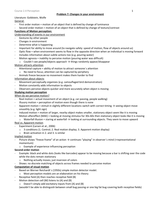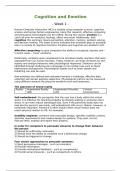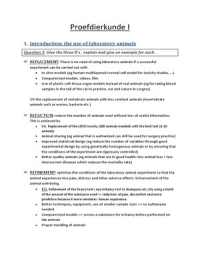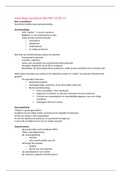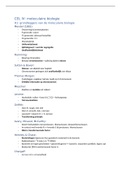Sustainable Supply Chain Management
Collegedictaat
Lecture 1 – Introduction to Sustainable Supply Chain Management
Lecture objectives
- Outlining purpose and content of the course
- Understanding the importance of sustainability in a supply chain
- Introduction of key concepts
- Explaining the structure of the course
Why this course?
- Many decision/policy makers find it hard to quantify “sustainability”
- Quantification of “sustainable solution” can be a prerequisite to deviate from
regulations
- Sustainability transition requires quantification: old situation experiments theory
(models) new situation
Course objectives
- Analyze supply chain problems taking into account interests of different stakeholders
(economic, ecological, societal and others) and evaluate (future) performance effects
of supply chain policy options
- Use a sustainable supply chain analysis framework to assess contemporary topics in
sustainable supply chain management
- Quantify the economic, ecological and societal objectives for supply chain
management cases
- Understand the transition from a linear to a closed loop (circular) economy
Definition of sustainability
- Brundtland UN Commissions definition of sustainable development
o Answer to the growing combination of environmental degradation, lasting
poverty and underdevelopment
o “development that meets the needs of the present without compromising the
ability of future generations to meet their own needs”
- People-Planet-Profit framework
o Introduced on the 2005 World Summit of the UN
o Definition of the three pillars of sustainability
o Analytical
(figure a) versus
systems
approach (fig b)
sustainability
o Analytical
modeling
sustainability
,The need for sustainable supply chain management
- Sustainable supply chain management is the management of a network of
interconnected businesses involved in the ultimate provision of product and service
packages required by and costumers (Harland 1996). This encompasses:
o Necessary movement
o Storage of raw materials
o Work-in-process inventory
o And finished goods from the point-of-origin to the point-of-consumption
- Continual increase for freight transport demand
o Increasing demand for physical products
o Influenced by many supply chain management decisions (Just-In-Time, lead
production and Efficient Consumer Response)
o Wider geographical sourcing of suppliers and wider distribution of finished
production is extending supply chains, both upstream and downstream
o Supported by the ease with which information can now flow between different
firms throughout the world in real-time
o Companies focusing on their core competencies
o Reverse logistics may increase transport demand and potentially reduce
utilization rates
o E-commerce
- The implications of modern supply chain management
o Since the 1975, freight transport is growing at a fast rate associated with
economic growth (world GDP growth)
o Growth mostly driven by emerging developing countries
The role of sustainability in a supply chain
- Supply chains interact with each other
o Supply chain surplus must be extended beyond the interest of its participants
Traditional definition of supply chain surplus:
Supply chain surplus = revenue generated from a customer –
total cost incurred to produce and deliver the product
o In a finite world, the environment component becomes important once the
environmental limits are reached
- The sustainability paradox
o Growth of emerging markets, improves the global living standard and helps
the poor to develop
o But this growth puts pressure
on resources and the
environment
o In general, GDP and population
growth are currently depleting
the natural resources faster that
, what is sustainably accepted. Steady state economy is a solution proposed by
environmental economists
- Many biophysical thresholds are surpassed, resulting in a carbon footprint overshoot
(see lectures on System Dynamics)
- Factors driving increased focus on supply chain (SC) sustainability
o Reducing SC risk and improving the financial performance of the supply chain
o Community pressures and government mandates
o Attracting customers that value sustainability
o Innovation
- Examples
o Replacing lightning by LED technology by Walmart, reduced energy costs and
CO2 emissions
o Use of aluminum in cars reduces weight and CO2 emissions by decrease of
fuel consumption
HBR (2009) – Why sustainability is now the key driver of innovation
1. Viewing compliance as opportunity
2. Making value chains sustainable
3. Designing sustainable products and services
4. Developing new business models
“Why a sustainably supply chain is good business” (Accenture)
Examples of energy management and sustainability best practices
,
Collegedictaat
Lecture 1 – Introduction to Sustainable Supply Chain Management
Lecture objectives
- Outlining purpose and content of the course
- Understanding the importance of sustainability in a supply chain
- Introduction of key concepts
- Explaining the structure of the course
Why this course?
- Many decision/policy makers find it hard to quantify “sustainability”
- Quantification of “sustainable solution” can be a prerequisite to deviate from
regulations
- Sustainability transition requires quantification: old situation experiments theory
(models) new situation
Course objectives
- Analyze supply chain problems taking into account interests of different stakeholders
(economic, ecological, societal and others) and evaluate (future) performance effects
of supply chain policy options
- Use a sustainable supply chain analysis framework to assess contemporary topics in
sustainable supply chain management
- Quantify the economic, ecological and societal objectives for supply chain
management cases
- Understand the transition from a linear to a closed loop (circular) economy
Definition of sustainability
- Brundtland UN Commissions definition of sustainable development
o Answer to the growing combination of environmental degradation, lasting
poverty and underdevelopment
o “development that meets the needs of the present without compromising the
ability of future generations to meet their own needs”
- People-Planet-Profit framework
o Introduced on the 2005 World Summit of the UN
o Definition of the three pillars of sustainability
o Analytical
(figure a) versus
systems
approach (fig b)
sustainability
o Analytical
modeling
sustainability
,The need for sustainable supply chain management
- Sustainable supply chain management is the management of a network of
interconnected businesses involved in the ultimate provision of product and service
packages required by and costumers (Harland 1996). This encompasses:
o Necessary movement
o Storage of raw materials
o Work-in-process inventory
o And finished goods from the point-of-origin to the point-of-consumption
- Continual increase for freight transport demand
o Increasing demand for physical products
o Influenced by many supply chain management decisions (Just-In-Time, lead
production and Efficient Consumer Response)
o Wider geographical sourcing of suppliers and wider distribution of finished
production is extending supply chains, both upstream and downstream
o Supported by the ease with which information can now flow between different
firms throughout the world in real-time
o Companies focusing on their core competencies
o Reverse logistics may increase transport demand and potentially reduce
utilization rates
o E-commerce
- The implications of modern supply chain management
o Since the 1975, freight transport is growing at a fast rate associated with
economic growth (world GDP growth)
o Growth mostly driven by emerging developing countries
The role of sustainability in a supply chain
- Supply chains interact with each other
o Supply chain surplus must be extended beyond the interest of its participants
Traditional definition of supply chain surplus:
Supply chain surplus = revenue generated from a customer –
total cost incurred to produce and deliver the product
o In a finite world, the environment component becomes important once the
environmental limits are reached
- The sustainability paradox
o Growth of emerging markets, improves the global living standard and helps
the poor to develop
o But this growth puts pressure
on resources and the
environment
o In general, GDP and population
growth are currently depleting
the natural resources faster that
, what is sustainably accepted. Steady state economy is a solution proposed by
environmental economists
- Many biophysical thresholds are surpassed, resulting in a carbon footprint overshoot
(see lectures on System Dynamics)
- Factors driving increased focus on supply chain (SC) sustainability
o Reducing SC risk and improving the financial performance of the supply chain
o Community pressures and government mandates
o Attracting customers that value sustainability
o Innovation
- Examples
o Replacing lightning by LED technology by Walmart, reduced energy costs and
CO2 emissions
o Use of aluminum in cars reduces weight and CO2 emissions by decrease of
fuel consumption
HBR (2009) – Why sustainability is now the key driver of innovation
1. Viewing compliance as opportunity
2. Making value chains sustainable
3. Designing sustainable products and services
4. Developing new business models
“Why a sustainably supply chain is good business” (Accenture)
Examples of energy management and sustainability best practices
,


